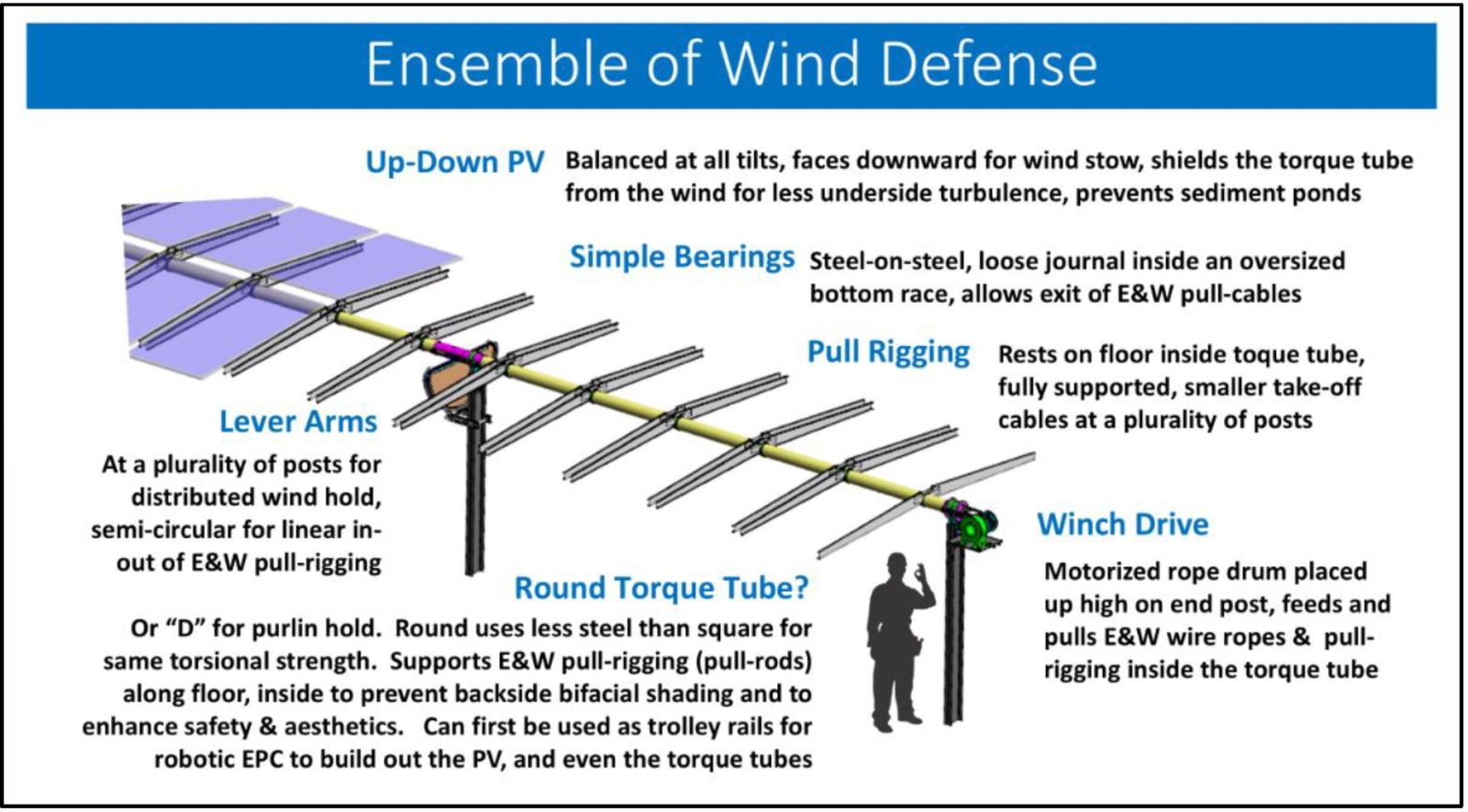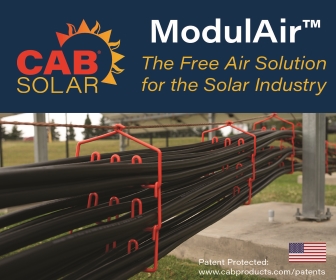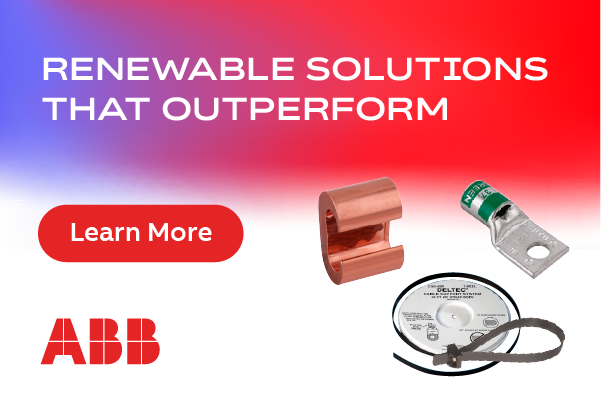Against the Wind
Single axis trackers used for PV solar farms must be reliable in the wind. This becomes more of a challenge if the tracker must also be low cost, involving capex, EPC, and opex (O&M). Wind failures are costly, and thus the comprehensive solution must involve innovative resolves that reduce steel, costs, complication, vulnerability to the wind, and solar farm LCOE.
The primary defense against wind failure is stiffness of the tracker row, achieved by these methods to varying effectivity and costs:
- Heavy, strong torque tube of steel
- Light, strong torque tube of costly composite or other future cost-effective material
- Damping, with reduced torque tube steel
- Positioning the PV downward into the oncoming wind
- Neutral or low center of gravity, not top-heavy
- Distributed drive, with much reduced torque tube steel
Let’s break down each method.
#1 Is not a viable option as the consistent goal is to reduce the amount of steel.
#2 Banks on the availability of an as-yet-developed material, indeed too expensive or impractical for today, and recyclability is always a concern, so let this potential solution be farther in the future, not a next-generation tracker needed today.
#3 Has many limitations. For starters, it only works when the tracker starts to oscillate. Allowed small oscillations could foster micro-fractures in the crystalline PV cells. Most rows are top-heavy, which means the static torque when tilted 45 degrees east or west is not held by distributed dynamic damping, only by the motorized drive in the row’s center. The somewhat light torque tube twists from the center drive outwards along each wing, with up to a 5-degree difference in tilt between the center drive and the wings’ outermost PV modules, creating series mismatch, reduced production, and high LCOE. The shock absorbers (dampers) add more backside shading to bifacial PV modules, ensuring poor bifacial performance. Bifacial gain could be and should be 12 percent on the average, but trackers in practice deliver just 2 – 5 percent gain, on the average. There exists an innovative, low-cost, 30-year solution that recovers that lost bifacial capacity, lowering LCOE by 5 – 10 percent.
#4 Requires knowledge of wind direction in addition to wind speed. If the direction comes from the north or south, and changes direction a bit, then the “which way to tilt?” guess work becomes fickle. To avoid this extra need of telemetry, many top-heavy trackers stow flat in the high wind to minimize cross sectional area. However, this is less stable than facing slightly downward into the wind and is more at risk of wind-gallop (if you’re in a moving car and extend your flattened hand out into the oncoming wind, you’ll observe the up-down force and the galloping effect of a relaxed, non-stiff arm). Furthermore, rain often accompanies wind and thus a flat stow creates sediment ponds that obscure the frontside to varying degrees and reduce the series string of modules proportionally, increasing LCOE.
#5 Is achieved with a few 1P (one in portrait) trackers that require bearings that swing, rocking the PV about a lower center of gravity. The torque tube does not twist when at a static tilt (such as 45 degrees), but it does require special bearings that sometimes stick above the surface of the PV, which casts topside shadows when back-tracking in summer and winter months. However, the majority of 1P and 2P trackers are top-heavy, with a coplanar table of PV. There is a strain on the drive system and a twist on the torque tube when the tracker row is tilted.
#6 Is the engineering challenge many have taken on. Multiple holding points along a plurality of posts establishes excellent stiffness with the lightest of torque tubes. The trick is to minimize the cost, complexity, and failure modes of the multiple holding points. Some distributed drives’ holding points employ exposed, large sharp-toothed half-gears that can catch fingers, clothing, or sheep wool. They entail a spinning driveshaft at hip level that blocks E-W passage for EPC, O&M, farm equipment (agrivoltaics), and fauna (grazing, wildlife corridor). Other distributed holding methods deploy a plurality of mechanical “transmissions” with gears, oil, lever arms, spinning shafts, gaskets, and seals. Oil leaks are then more numerous and more widely distributed on the land. The plurality of mechanical drives (transmissions) per row are powered by a daisy-chain of exposed, spinning driveshafts that shade the bifacial backside. Generally, there is one motorized drive at the center of the row and two satellite drives, one down each wing, powered by spinning driveshafts. Some trackers have abandoned the driveshafts and placed a motor on each drive. A long torque tube with three motorized drives is the same as three short trackers each with a motorized drive. The increase in complexity, distributed O&M, and failure nodes increases the LCOE. The bell curve of distributed drives on the market captures the wide field of compromises made with the KPI goals related to steel, reliability, safety, simplicity, costs (capex, EPC, opex), and PV output. Why compromise when one can synergize?

This sketch summarizes the ensemble of design attributes that best ensure reliable wind hold, low cost, and low LCOE for PV solar farms. The balanced up-down PV can be achieved on faceted torque tubes (square, octagon, “D”) with a simple non-planar purlin that attaches to the faceted torque tube in the same fashion as a planar (straight) purlin.

Two full-size tracker rows and one short row at California Polytechnic University San Luis Obispo underwent testing from 2018 to 2022. The photographs on the left and in the center show one of the two full-length rows with a sample of up-down 2P. The right photograph shows a balanced set of three 2P’s, balanced even at this very high tilt; a single hand can turn that row.
Clearly, the ideal tracker is both lowest in total cost of ownership while still being very wind resilient. The industry must aim to fill the need of solar owners everywhere: an ensemble of design attributes that best ensure reliable wind hold, low cost, and low LCOE for PV solar farms.
Robert Dally has 46 years in solar PV. He started at Arco Solar in 1979. For the next 13 years he designed solar panels for satellites. He returned to his passion of terrestrial PV in 2000, feeding his keen interest in developing the better mousetrap of a single axis tracker mounting system. He is the inventor on seven tracker patents with five more pending. He has developed and directed PV project teams around the world and would love another opportunity to travel internationally for work. Robert developed two previous trackers for two previous companies, the products having been deployed for over 600 MW before being retired out five years ago. He has a BSEE, BA Spanish, and MBA from California State University, Northridge.
Sun and Steel | www.sunandsteelsolar.com
Author: Robert Dally
Volume: 2025 July/August











.jpg?r=6386)
